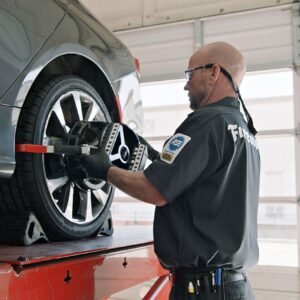When it comes to maintaining your vehicle, tire pressure is often overlooked, yet it plays a vital role in your car’s safety and performance. But how do you know what the recommended tire pressure for cars is? This guide will help you understand why proper tire pressure is essential and how you can ensure your tires are at their optimal levels for the best driving experience.
Check out our Tire pressure guide for optimal vehicle safety
Why Tire Pressure Matters More Than You Think
Tire pressure is critical for the proper function of your vehicle. Under-inflated tires can reduce fuel efficiency, cause uneven tire wear, and even lead to a blowout. On the other hand, over-inflated tires can cause poor handling, reduced traction, and an uncomfortable ride. Maintaining the recommended tire pressure for cars helps to optimize tire lifespan, improve safety, and enhance overall vehicle performance. It’s crucial to understand that tire pressure affects both fuel economy and your car’s handling, making it an essential part of regular car maintenance.
How to Find the Correct Tire Pressure for Your Vehicle
Every car has its own recommended tire pressure for cars, and it’s important to know where to look for this information. Typically, this information can be found on a sticker inside the driver’s side door frame, often on the doorjamb or the fuel door. You can also refer to your vehicle’s owner’s manual for the precise tire pressure recommendation. This number is usually provided in PSI (pounds per square inch). Optimal tire PSI varies depending on the make, model, and weight of your vehicle, so always check the correct specifications for your specific car.
Understanding PSI and Its Impact on Your Tires
PSI stands for pounds per square inch, a unit of measurement used to measure air pressure. The optimal tire PSI is the recommended level of air pressure for your tires, ensuring they are properly inflated for maximum performance and safety. Tires that are under-inflated by even a few PSI can decrease fuel efficiency, increase tire wear, and reduce the vehicle’s handling ability. Conversely, over-inflating your tires can make them more prone to damage and compromise your ability to drive safely, especially on rough or wet roads.
The Risks of Driving with Incorrect Tire Pressure
Driving with incorrect tire pressure can have serious consequences. Under-inflated tires cause friction and heat, which can lead to tire blowouts. They also increase the rolling resistance of your vehicle, leading to reduced fuel efficiency and faster tire wear. On the other hand, over-inflated tires reduce the contact area between the tire and the road, leading to poor traction, especially in wet conditions. Both conditions significantly affect the safety and performance of your car, which is why it’s crucial to regularly check your tire pressure and keep it within the recommended tire pressure for cars.
How Often Should You Check Your Tire Pressure?
To maintain the optimal tire PSI, it’s important to check your tire pressure regularly. Ideally, you should check it at least once a month and before long trips. Tire pressure can fluctuate with temperature changes; for every 10°F decrease in outside temperature, tire pressure can drop by 1 PSI. It’s best to check tire pressure when the tires are cold, as driving heats up the tires and can give you inaccurate readings. Keeping your tires at the recommended tire pressure for cars ensures better safety, tire longevity, and efficiency.
The Role of Temperature in Tire Pressure
Temperature changes can significantly impact your tire pressure. As mentioned earlier, optimal tire PSI is affected by the temperature of the environment. Cold weather causes the air in your tires to contract, reducing tire pressure, while hot weather causes the air to expand, increasing tire pressure. This fluctuation can lead to unsafe driving conditions if not regularly monitored. When the weather changes, it’s important to check tire pressure to ensure it remains within the recommended range for your car, especially during seasonal transitions.
How to Properly Inflate Your Tires
To maintain the recommended tire pressure for cars, you need to know how to properly inflate your tires. First, purchase a reliable tire pressure gauge to measure the current pressure. Then, use an air compressor at a gas station or at home to add air to your tires. Be sure to check the tire pressure regularly and stop when the pressure matches the optimal tire PSI recommended by the manufacturer. Avoid over-inflating, as this can cause undue stress on the tire and result in poor handling. Proper inflation ensures your vehicle’s safety and performance.

Common Tire Pressure Mistakes to Avoid
Many drivers make common mistakes when it comes to tire pressure. One mistake is assuming that tire pressure doesn’t need to be checked regularly. Under-inflation and over-inflation are often not obvious at first glance, which is why it’s important to check your tires frequently. Another common mistake is relying solely on the appearance of the tire or the “feeling” of the car’s ride to assess tire pressure. While tires may appear fine visually, the air pressure can still be off. Always use a tire pressure gauge to get an accurate reading and keep your tires inflated to the recommended tire pressure for cars.
How Tire Pressure Affects Your Vehicle’s Fuel Efficiency
One of the most significant benefits of keeping your tires inflated to the optimal tire PSI is improved fuel efficiency. Tires that are properly inflated have less rolling resistance, which means the engine doesn’t have to work as hard to move the vehicle. This results in better fuel economy and can save you money at the gas pump over time. In fact, under-inflated tires can reduce fuel efficiency by up to 3%, making regular tire pressure checks an easy way to improve your car’s efficiency and reduce carbon emissions.
The Importance of Tire Maintenance and Regular Inspections
Maintaining the recommended tire pressure for cars is part of a broader commitment to tire maintenance. Regular inspections, including checking for tread wear, cracks, or other damage, can help prevent unexpected blowouts or costly repairs. It’s also a good idea to rotate your tires regularly to ensure even wear. When combined with proper tire inflation, these practices help keep your car running smoothly, improve safety, and extend the life of your tires.
Conclusion: Keep Your Tires in Top Condition for a Safer, More Efficient Ride
In conclusion, maintaining the recommended tire pressure for cars is vital for your safety, the longevity of your tires, and the overall performance of your vehicle. By following the tips provided, including regular tire pressure checks, ensuring you’re using the optimal tire PSI, and taking care of your tires with proper inflation and maintenance, you’ll enjoy a smoother, safer ride and avoid unnecessary expenses. Make tire pressure checks a part of your routine car maintenance and keep your vehicle performing at its best.
Prepare your car for the season with Winter car prep New York tips





